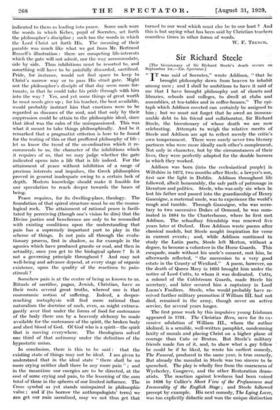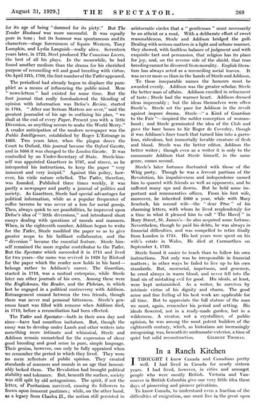Sir Richard Steele
[The bicentenary of Sir Richard Steele's death occurs on September lst.—En. Spectator.] " IT was said of Socrates," wrote Addison, "that he brought philosophy down from heaven to inhabit among men ; and I shall be ambitious to have it said of me that I have brought philosophy out of closets and libraries, schools and colleges, to dwell at clubs and assemblies, at tea-tables and in coffee-houses." The epi- taph which Addison coveted can certainly be assigned to him ; but we must not forget that he owed an immeas- urable debt to his friend and collaborator, Sir Richard Steele, the bicentenary of whose death we are now celebrating. Attempts to weigh the relative merits of Steele and Addison are apt to reflect merely the critic's own temperament. There were surely never two literary partners who were More ideally each other's complement. Not only in character, but by the circumstances of their lives, they were perfectly adapted for the double harness in which they worked.
Addison was born (into the ecclesiastical purple) in Wiltshire in 1672, two months after Steele, a lawyer's son, first saw the light in Dublin. Addison throughout life followed, albeit honourably, the safe path of patronage in literature and politics. Steele, who was only six when he lost his father and -passed into the guardianship of Henry Gascoigne, a maternal uncle, was to experience the world's rough and tumble. Through Gascoigne, who was secre- tary to two successive Dukes of Ormond, he was nom- inated in 1684 to the Charterhouse, where he first met Addison. The schoolboy friendship was renewed five years later at Oxford. Here Addison wrote poems after classical models, but Steele sought inspiration for verse in current events ; and, while Addison continued to study the Latin poets, Steele left Merton, without a degree, to become a volunteer in the Horse Guards. This escapade, made without his uncle's consent, cost him, he afterwards reflected, "the succession to a very good estate in the County of Wexford." A poem, however, on the death of Queen Mary in 1695 brought him under the notice of Lord Cutts, to whom it was dedicated. Cutts, a colonel of the Coldstream Guards, made Steele his secretary, and later secured him a captaincy in Lord Lucas's Fusiliers. Steele, who would probably have re- ceived further military promotion if William III, had not died, remained in the army, though never on active service, for several years longer.
The first prose work by this impulsive young Irishman appeared in 1701. The Christian Hero, save for its ex- cessive adulation of William III., whom the author idolized, is a sensible, well-written pamphlet, condemning laxity of morals and placing Christ on a higher plane of courage than Cato or Brutus. But Steele's military friends made fun of it, and, to show what a gay fellow he could be if he liked, he wrote his earliest comedy. The Funeral, produced in the same year, is true comedy. But already the moralist in Steele was too sincere to be quenched. The play is wholly free from the coarseness of Wycherley, Congreve, and the other Restoration dram- atists. The reaction against lewdness had been voiced in 1698 by Collier's Short View of the Profaneness and Immorality of the English Stage ; and Steele followed precept by example. His next comedy, The Lying Lover, was too explicitly didactic and won the unique distinction for its age of being "damned for its piety." But The Tender Husband was more successful. It was equally pure in tone ; but its humour was spontaneous and its characters—stage forerunners of Squire Western, Tony Lumpkin, and Lydia Languish—really alive. Seventeen years later, in 1722, Steel produced The Conscious Lovers, the best of all his plays. In the meanwhile, he had found another medium than the drama for his cherished purpose of reconciling wit and good breeding with virtue. On April 12th, 1709, the first number of the Tatter appeared.
The periodical had already begun to displace the pam- phlet as a means of influencing the public mind. Mere "news-letters" had existed for some time. But the first journal that really foreshadowed the blending of opinion with information was Defoe's Review, started in 1704. "After our Serious Matters are over," said the greatest journalist of his age in outlining his plan, "we shall at the end of every Paper, Present you with a little Diversion, as anything occurs to make the World Merry." A cruder anticipation of the modern newspaper was the Public Intelligencer, established by Roger L'Estrange in 1663. Two years later, when the plague drove the Court to Oxford, this journal became the Oxford Gazette, and in 1666 it was changed to the London Gazette. It was controlled by an Under-Secretary of State. Steele him- self was appointed Gazetteer in 1707, and strove, as he interpreted his instructions, to keep the paper "very innocent and very insipid." Against this policy, how- ever, his virile nature rebelled. The Taller, therefore, was founded. Published three times weekly, it was partly a newspaper and partly a journal of politics and society. As Gazetteer, Steele had special advantages for political information, while as a popular frequenter of • coffee taverns he was never at a loss for social gossip. Then, always quick to see possibilities, he improved upon Defoe's idea of "little diversions," and introduced short essays dealing with questions of morals and manners. When, in the eighteenth number, Addison began to write for the Taller, Steele modified the paper so as to give greater scope to his brilliant collaborator, and the " diversion " became the essential feature. Steele him- self remained the more regular contributor to the Taller. But the Spectator which succeeded it in 1711 and lived for two years—the name was revived in 1828 by Rintoul for the paper which the reader now holds in his hand— belongs rather to Addison's career. The Guardian, started in 1713, was a mutual enterprise, while Steele later ran other journals of his own. Among these were the Englishman, the Reader, and the Plebeian, in which last he engaged in a political controversy with Addison. Estrangement ensued between the two friends, though there was never real personal bitterness. Steele's gen- erous heart was filled with remorse when Addison died, in 1719, before a reconciliation had been effected.
The Taller and Spectator—both in their own day and since—have had countless imitators. But, though the essay was to develop under Lamb and other writers into something more intimate and whimsical, Steele and Addison remain unmatched for the expression of sheer good breeding and good sense in pure, simple language. Their genius, however, can only be fully appraised when we remember the period in which they lived: They were ' mere reflectors of public opinion. They created , standards of manners and morals in an age that lament- ably lacked them. The Revolution had brought political stability and tolerance. But, beneath the surface, society was still split by old antagonisms. The spirit, if not the letter, of Puritanism survived, causing its followers to frown upon innocent pastimes ; while, on the other hand, as a legacy from Charles IL, the notion still persisted in aristocratic circles that a " gentleman " must necessarily be an atheist or a roufS. With a deliberate effort of sweet reasonableness, Steele and Addison bridged the gulf. Dealing with serious matters in a light and urbane manner, they showed, with faultless balance of judgment and with exquisite tact and persuasion, that religion has its place for joy, and, on the reverse side of the shield, that true breeding cannot be divorced from morality. English litera- ture has always acted as a reconciling social leaven. It was never more so than in the hands of Steele and Addison.
To these inseparable names the honours must be awarded evenly. Addison was the greater scholar, Steele the better man of affairs. Addison excelled in refinement of taste ; Steele had the warmer heart. Addison dressed ideas impeccably ; but the ideas themselves were often Steele's. Steele set the pace for Addison in the revolt against impure drama. Steele—" a Kind of Guardian to the Fair "—inspired the nobler conception of woman- hood ; and Steele germinated the idea of the Club and gave the bare bones to Sir Roger de Coverley, though it was Addison's finer touch that turned him into a garru- lous, ridiculous, but immortally lovable creature of flesh and blood. Steele was the better editor, Addison the better writer ; though even as a writer it is only to the consumate Addison that Steele himself, in the same genre, comes second.
Steele's later fortunes fluctuated with those of the Whig party. Though he was a fervent partisan of the Revolution, his impulsiveness and. independence caused him to quarrel with friends as well as opponents, and he suffered many ups and downs. But he held some im- portant and remunerative offices. From his first wife, moreover, he inherited £800 a year, while with Mary Scurlock, his second wife—the "dear Prue" of his charming letters, with whom he lived, resplendently for a time in what it pleased him to call "The Ilov4 " in Bury Street, St. James's—he also acquired some foikune. Nevertheless, though he paid his debts, he was always in financial difficulties, and was compelled to retire filially from London in 1724. His last years were spent on his wife's estate in Wales. He died at Carmarthen on September 1, 1729.
Steele found it easier to teach than to follow his own instructions. Not only was he irresponsible in financial matters ; in other ways he failed to live up to his own standards. But, mercurial, impetuous, and generopp, he erred always in warm blood, and never fell into die final sin of mistaking evil for good. His ideals, at least, were kept untarnished. As a writer, he survives by intrinsic virtue of his dignity and charm. The good sense and fine feeling of his best work are applicable for all time. But to appreciate the full stature of the man we must, again, remember his period and setting. His ideals flowered, not in a ready-made garden, but in a wilderness. A creator, not a crystallizer, of public opinion, he was among the most potent builders of the eighteenth century, which, as historians are increasingly recognizing, was, beneath its undramatic exterior, a time of quiet but solid reconstruction. GILBERT THOMAS.

































 Previous page
Previous page